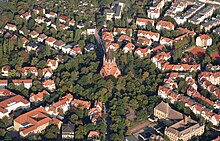Paulusviertel (Halle)
|
Paulusviertel district of Halle (Saale) |
|
|---|---|
| Coordinates | 51 ° 29 '44 " N , 11 ° 58' 26" E |
| surface | 1,075.0 km² |
| Residents | 12,432 (Dec. 31, 2015) |
| Population density | 11,565 inhabitants / km² |
| Postcodes | 06108, 06114 |
| prefix | 0345 |
| country | Saxony-Anhalt |
The Paulusviertel is a district around the Pauluskirche in Halle (Saale) . It belongs to the Halle district in the north district and is bordered in the south by Ludwig-Wucherer-Strasse, in the north and east by Paracelsusstrasse and in the west by Reilstrasse. 12,432 citizens currently live in the district.
history
The Paulusviertel was planned at the end of the 19th century, during the tenure of city building officer Ewald Genzmer (1892–1904), “on the drawing board” under the name Kaiserviertel as a new district for professors, civil servants and employees. Building began around 1900 in the style of historicism typical of the time , but Art Nouveau (e.g. on Schleiermacherstraße) or new buildings (e.g. on Steffensstraße and Albert-Schweitzer-Straße) are also available. Construction work came to a standstill during the First World War . The originally planned ring between today's Herweghstrasse and the eastern end of Schleiermacherstrasse was never completely closed. The reason for this lay primarily in the building ground, which had been destabilized by an abandoned underground mine , which had already led to a break in the daylight and was judged to be inadequate for further development.
Between 1949 and 1990 there was an increasing deterioration of the building fabric, which was partially halted after reunification . The quarter became particularly popular with students due to the low rents and the relative proximity to the university , even if the prices rose again in the 2000s compared to other parts of Halle. Today, young families with children in particular shape the image of the Paulusviertel.
politics
The European elections 2019 , which took place at the same time, and the city council elections in Halle (Saale) on May 26, 2019, produced the following result for the Paulusviertel:
|
City council election in Halle (Saale) 2019 in the Paulusviertel
% 30th 20th 10
0
28.6%
17.5%
15.1%
12.0%
6.0%
5.8%
5.5%
4.2%
3.9%
1.5%
|
Infrastructure
The center of the Paulusviertel is the Pauluskirche , which stands on the hill - called "Hasenberg" - in the center of the quarter. The Evangelical Paulus Congregation uses the church for its worship services and numerous other events. The parish office and parish hall of the Paulusgemeinde is located at Robert-Blum-Straße 11.
The philosophy branch library (Ha 75) of the ULB Sachsen-Anhalt was located on Schleiermacherstraße until late summer 2015 , and is now part of the library on the Steintor campus. Courses from the Philosophical Faculty of the Martin Luther University Halle-Wittenberg also took place in the building. In the area of the Paulusviertel there are two primary schools and the day care center of the Evangelical Paulus Congregation.
The Halle employment agency , the city's land registry office and an animal shelter are also located in the Paulusviertel . The Hallenser Wingolf , one of Halle's oldest student associations , has been using its original corporation house on Robert-Blum-Strasse, the second oldest in the city , since 2004 .
Up until 2014, the farmers' club , a student club of agricultural and nutritional scientists from the MLU Halle-Wittenberg, was located in the immediate vicinity of the Steintor . The tennis courts of the TC HALLE 94 EV can be found on Schleiermacherstrasse (between the corner of Humboldtstrasse and Herderstrasse) . The citizens' initiative Paulusviertel e. V., which organized the annual Pauline Festival, has its office at Hegelstrasse 15.
There is a shortage of available parking spaces in the Paulusviertel . According to a study commissioned by the city, there are around 4,000 residents' cars for every 2,900 free public parking spaces.
literature
- Sandra Kowalski: Civil segregation and urban planning - the emergence of the Paulusviertel , in: Werner Freitag, Katrin Minner, Andreas Ranft (ed.): History of the city of Halle , Vol. 2: Halle in the 19th and 20th centuries . Mitteldeutscher Verlag , Halle 2006, ISBN 3-89812-383-9 , pp. 200-213.
- Andreas Jüttemann & Christian Schlöder: On the way between Paulusviertel and Giebichenstein Castle . Mitteldeutscher Verlag , Halle 2017, ISBN 978-3-95462-721-9
Web links
- Citizens' Initiative Paulusviertel e. V.
- Evangelical Paulus Congregation Halle
- Philosophy branch library (Ha 75)
Individual evidence
- ^ City of Halle: The Paulusviertel district
- ↑ Halle in figures 2015
- ↑ Election to the 9th European Parliament in the independent city of Halle (Saale) on May 26, 2019, election of the city council in the independent city of Halle (Saale) on May 26, 2019. Retrieved on August 18, 2019 .
- ^ Detlev Haupt: Citizens' festival in the Paulusviertel Halle. In: www.bi-paulusviertel.de. Retrieved August 30, 2016 .
- ↑ Paulusviertel in Halle: Wild West parking forever? . In: Mitteldeutsche Zeitung . March 25, 2015.
- ^ Looking for ways out of the parking space problem , Mitteldeutsche Zeitung of January 12, 2016



